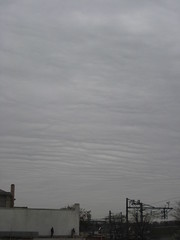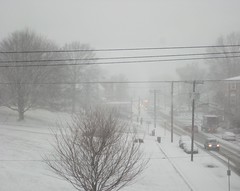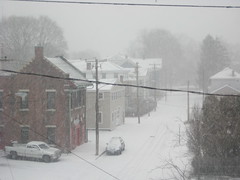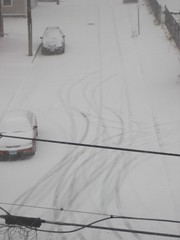I saw this meme over at Easily Distracted and liked it so much that I'm stealing it. The rules are simple: name a favorite movie for each letter of the alphabet. So here are mine.
After Life: I'm reluctant to give any summary, because any summary would make it sound cheesy. Just go watch it if you haven't already.
Babette's Feast and My Beautiful Laundrette (tie): I can't decide. Both of these are on my desert-island list. I considered putting My Beautiful Laundrette under M, but M was crowded with possibilities already. Runner-up: Bull Durham.
The Company: The first of several Robert Altman movies on the list (see also G and M). I love the scene with Neve Campbell's character playing pool by herself in the bar.
Dark City: This one makes the list largely for the amazing Edward-Hopper-esque visuals, but I don't care.
Eternal Sunshine of the Spotless Mind: I've watched a lot of movies about memory, some sublime (see After Life) and some crappy (the lame adaptation of William Gibson's Johnny Mnemonic comes to mind). This one is definitely on the high end of the scale.
The Full Monty: Especially for the scene where they start unconsciously rehearsing their chorus-line routine while waiting in the unemployment office. Or perhaps Fargo, mostly for Frances McDormand: "Oh for Pete's sake, he's fleeing the interview. He's fleeing the interview!"
Gosford Park: Altman has a way of taking well-worn genres (the war movie, the Western) and doing things to them you never expected. Here he turns the English country-house murder mystery inside out.
High Fidelity: "That's the worst f$!@ing sweater I've ever seen. It's a Cosby sweater. A Cosssby sweatah!" Jack Black is my favorite thing about this movie. If I'm ever in a band, I want it to be named Sonic Death Monkey.
Italiensk for begyndere (Italian for Beginners): I never thought I'd enjoy a Dogme95 film so much.
What to pick for J? The dark and disturbing Jacob's Ladder, which messes with your head seven ways to Sunday, or the much sunnier and happier Juno? Or I might just cheat a bit and say (Being) John Malkovich.
The only thing I can think of for K is Kind Hearts and Coronets, with Alec Guinness as a whole series of members of a wealthy family who get bumped off one by one by the protagonist. It's been a while since I saw it, but I have fond recollections.
Life Is Sweet: I had to get some Mike Leigh in here somewhere, and this is one of my favorites. But I could also have gone with the Lord of the Rings trilogy considered as one massively long three-part work.
McCabe and Mrs. Miller: As the Lorraine Bowen song goes, I'm in love with Julie Christie (she makes me go misty). Runners-up: Magnolia, Memento, Monty Python and the Holy Grail, Moonstruck, and Moulin Rouge!. (Criminy. Do all my favorite movies start with the letter M?)
North by Northwest: Hitchcock obsession, I haz it (see also under V for Vertigo).
O Brother, Where Art Thou?: Love George Clooney in this one. And the soundtrack. And the Homeric intertextuality. And everything about it, really.
Party Girl: Every librarian's favorite movie! Also, I'll watch Parker Posey in nearly anything.
Queen Christina: Because it has Greta Garbo in 17th-century drag, assuring one of her courtiers "I will not die an old maid. I will die a bachelor!"
Le rayon vert (The Green Ray): Oddly, I'm not really a fan of Eric Rohmer's movies in general, just this one. It's hard to say why I love it. Not much happens apart from the main character screwing up her summer vacation plans. But you watch it a few times and you realize that not a single detail or shot or bit of dialogue is superfluous, and the ending feels like a miracle. Runners-up: The Royal Tenenbaums, and, on a totally different note, Romy and Michele's High School Reunion.
Singin' in the Rain and The Station Agent in a tie for S. Also Sunset Boulevard.
Trois Couleurs: Rouge: The whole Three Colors trilogy, really, but if I have to pick just one, then definitely the final one.
The Usual Suspects: Because it made a huge impression on me the first time I saw it, even though I suspect it probably doesn't hold up to repeated viewings as well as I once thought.
Vertigo: I went through a huge Hitchcock phase there for a while, and while it's no longer the obsession it once was, Vertigo was the movie that started it, and to this day it's way up there among my favorites. Runner-up: Velvet Goldmine.
Wonder Boys: There's just something about this movie that makes you feel like you're living inside its world. Also, Michael Douglas is brilliant as the pot-smoking, pink-chenille-bathrobe-wearing novelist who can't finish his enormous novel, and the writing workshop scenes crack me up. Runners-up: Wait Until Dark and The Wicker Man (the original version; I avoided the remake because I suffer from an allergy to Nicholas Cage).
X is the letter that gets left out of every abecedarium. Mine is no exception. (I just didn't like The X-Men enough to consider it a favorite. Or eXistenz, fo
r that matter.)
Y: Like Tim, I think it's probably cheating to put Y tu mamá también for Y. But without it I'm Y-less, and I really liked it. So I'll cheat.
Z: Zéro de conduite? Zazie dans le Métro? What is it with French movies about rebellious children with titles that start with Z? (Actually, neither of these are on my all-time favorites list, but I wanted to have a Z.)
So there you have it. Feel free to spread the meme!






